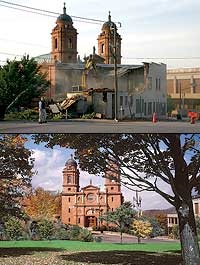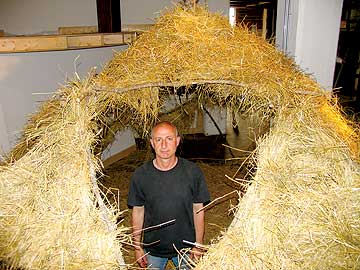Gay marriage controversy shifts to state level
While a constitutional amendment banning same-sex marriages has once again failed in Congress, gays and lesbians in North Carolina may want to shift their attention to the state level. Companion bills in the N.C. House and Senate now seek to accomplish what Congress could not.
“Whether they will be brought up for consideration this year is another question,” says John Rustin, director of government relations for the Raleigh-based North Carolina Family Policy Council. The council describes itself as a nonpartisan, nonprofit research-and-education organization “dedicated to the preservation of the family and traditional family values.”
Similar attempts last year went nowhere, thanks largely to the General Assembly’s Democratic leadership, which remains in power, notes Rustin. Such a move would require amending the state constitution, and to do that, three-fifths of both chambers of the General Assembly would have to approve it, along with a simple majority of voters.
North Carolina already has a law prohibiting same-sex marriages, but Rustin says a constitutional amendment is the only sure way to prevent legal challenges to the law.
“Marriage will be defined — either by activist judges who seek to redefine marriage or by amending our state and federal constitutions to support marriage between one man and one woman,” says council President Bill Brooks. “It is imperative that this decision be made by the people and not the courts.”
To recap the action in Washington: On June 7, the Senate voted 49-48 to limit debate and bring the amendment to a yes-or-no vote. That was 11 short of the 60 needed, effectively killing the Senate measure for this year, but it was one more vote than proponents mustered last year.
Arguments against the measure included a reluctance to restrict rights in a document designed to ensure them. In addition, many senators said they believe the issue should be decided by individual states, not the federal government.
Amending the Constitution requires two-thirds majorities in both houses of Congress. After that, the proposed amendment must be ratified by at least 38 states.
Despite the Senate’s failure, the House will take up the issue next month. Absent Senate approval, any action by the House is meaningless in practical terms, but it’s seen by many as a red-meat issue that’s likely to energize the religious and culturally conservative wing of the GOP leading up to the midterm elections in November.
— Hal Millard
Arida honors Bonesteel
When local filmmaker Paul Bonesteel was told that his work, talents and career were to be the focus of the 14th annual Arida Arts Symposium, he was “humble and surprised,” reports Lee Anna Haney of Blue Ridge Community College. Bonesteel, the creative force behind Bonesteel Films, has completed nine feature documentaries (several of which have appeared on PBS) as well as a variety of commercial projects. He’s also no stranger to the Arida Arts Symposium. His mother, nationally known quilter Georgia Bonesteel, was one of the first Western North Carolina artists to be so recognized.
Much of Bonesteel’s recent work has focused on the region, most notably the documentaries Folkmoot USA and The Mystery of George Masa, but that wasn’t the only thing that piqued the symposium’s interest.
“Filmmaking is an art that we have not yet honored,” Haney explains. “It’s both Paul and the art that he represents that are being honored. We’re going to focus on the documentaries and his art of being a producer, a director and a writer.”
The Arida Arts Symposium takes place Friday, June 16, 10 a.m. to 8 p.m. on the Blue Ridge Community College campus. A filmmaking workshop, a reception and a presentation about Bonesteel’s work are planned. All events are free, but space is limited and reservations are encouraged. For more information, call 694-1708 or visit www.blueridge.edu.
— Steve Shanafelt
Park or parking?

Once and future view?: Designer David Lynch created an image (at bottom) dubbed “St. Lawrence Park,” illustrating a possible future setting for Asheville’s world-renowned Basilica of St. Lawrence. At top, a backhoe removes debris from the recently demolished St. Justin Center, a retail/office structure used as a Catholic Sunday school and community center since 1980.
|
When Asheville’s Basilica of St. Lawrence was built in 1905, the lot across the street contained a one-story log cabin, soon to become the Bandanna Tea Room. During the 1920s the cabin was used as a doctor’s office, but it was razed some time before 1928, when a long, wedge-shaped structure was built for use as a Remington Rand office-equipment store.
By 1935, the structure was known as the Hapage Building (reflecting its location at the intersection of Haywood Street and Page Avenue), and through World War II it housed a barbershop. In 1950, Naiman & Co. was selling electrical fixtures there, and by 1958 the structure had been rechristened the Tricorn Building, though records indicate it was vacant at the time.
Radio Station WISE had its offices in the Tricorn in 1960, but a decade later the building was vacant again. It apparently remained so until the Diocese of Charlotte purchased it in 1980 to provide classroom space for Sunday school, dubbing it the St. Justin Center.
Acccording to Tim Brown of the diocese, the city of Asheville bought the building in 2003 as part of a plan to build a parking deck adjacent to the Battery Park Apartments, but other parts of the complex real-estate deal fell through, and the plan was abandoned. The city demolished the building last week to make way for 40 parking spaces.
This is the first time since the construction of the neighboring Grove Arcade, which opened to the public in 1929, that the basilica has been fully visible from that other early 20th-century architectural treasure. Since the Battery Park deck plan collapsed last fall, a number of community activists have been quietly advocating creation of a new downtown park facing the Civic Center.
“People have commented to me, ‘Wouldn’t it be wonderful if they really did build that park?'” Grove Corner Market owner Rosanne Kiely told Xpress. “There’s a wine bar going in on that corner of the Arcade, and imagine how sweet that would be to have that view.” Kiely conceded that there’s a need for more parking in the area, but she noted, “I think it would be beneficial for the arcade businesses to have a park there.”
The accompanying illustration by designer David Lynch indicates how the basilica might look framed by such a green space.
— Cecil Bothwell
Correction:Forgive us, city fathers, for we have sinned. In our June 14 issue, Xpress attributed to Tim Brown of the Diocese of Charlotte the statement that St. Justin’s Center was sold to the city of Asheville in 2003. But Ed Vess, the city’s real-estate manager, reports that the city is innocent of said ownership, and employees of Crouch Mitch House Moving Contractors (which demolished the building) confirmed, “We’re working for the Basilica [of St. Lawrence].”

Found objects: It was a red-eyed week for the artist H.K. Zamani. A flight took him from Los Angeles, away from the smog and ordered palms, to Asheville, with a final stop at the River District and its landscape of stink trees and kudzu bowers. Zamani’s opus, viewed on the eve of last weekend’s Studio Stroll, looked like the marriage of Buckminster Fuller and a nativity scene: a dome of lashed sticks laid over with piles of loose straw. It was delicate, ephemeral and odd. Zamani looked at it admiringly. “The sticks have so much personality,” he said. photo by Jon Elliston
|



Before you comment
The comments section is here to provide a platform for civil dialogue on the issues we face together as a local community. Xpress is committed to offering this platform for all voices, but when the tone of the discussion gets nasty or strays off topic, we believe many people choose not to participate. Xpress editors are determined to moderate comments to ensure a constructive interchange is maintained. All comments judged not to be in keeping with the spirit of civil discourse will be removed and repeat violators will be banned. See here for our terms of service. Thank you for being part of this effort to promote respectful discussion.